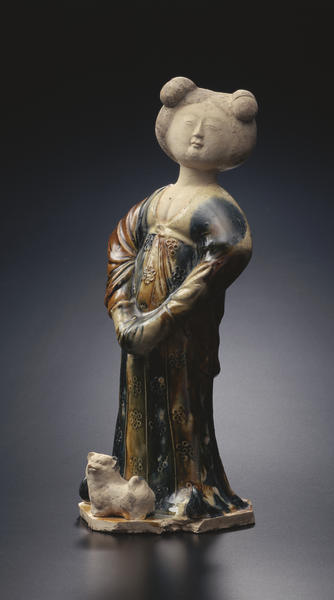Female Figure
- China, Tang period
- early 8th century
- Three-color glazed pottery
Catalogue Entry
Brimming with relaxed elegance, this example of Tang “tricolor” ceramic figurines shows the type of plump-fleshed woman that epitomized the period’s ideal of feminine beauty. She wears a robe with shoulder pads and a decollete low neckline, over which is wrapped a kind of shawl called a pei. Her long-skirted garment is decorated with vertical stripes and stamped seven-star crests, and the tips of pointy shoes jut out from under her hem. Her upper body leans slightly back and to the left, and nestling at her feet is a small dog. With her hair done up in two buns, the woman’s expression charmingly resembles that of her pet. A style of makeup known as huadian was popular in China at that time, and traces of vermilion remain on the figure’s lips. Tang tricolor wares first appeared at the end of the Early Tang period (ca. 618-710), and became popular as grave goods as the custom of lavish funerals took hold among aristocrats in Chang’an and Luoyang during the High Tang period (ca. 711-763). The clothing of the figurine is covered entirely in glazes of indigo, brown, green, and white, and the woman’s hair, eyebrows, and eyes, as well as the dog’s hair, are painted with sumi ink.
